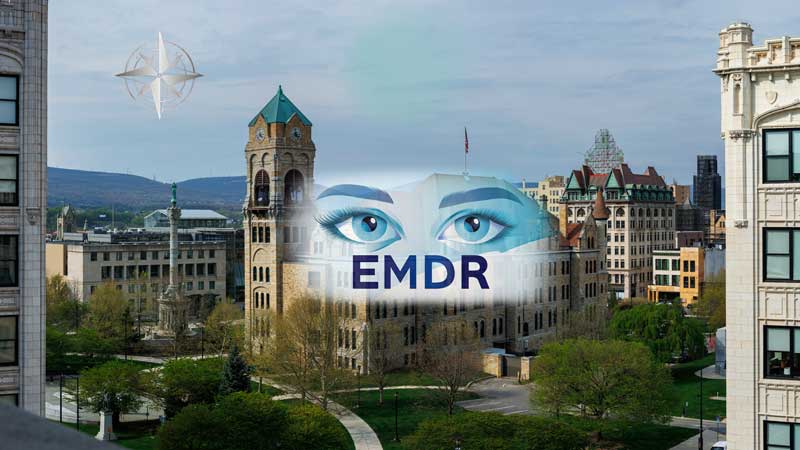Expert Online EMDR Therapy Services in Scranton, PA


313 West Liberty Street, Ste. 224
Lancaster, PA 17603

EMDR Therapy, which stands for Eye Movement Desensitization and Reprocessing Therapy, is an evidence-based treatment used by licensed professionals at ACRS for Trauma and PTSD counseling. We will work with you to determine if EMDR is the most suitable therapy for your unique needs. Our office is located in Lancaster, PA, but we also provide high-quality online telehealth EMDR Trauma and PTSD Counseling for our clients in Scranton.
EMDR Therapy is an excellent treatment modality for Trauma and PTSD. However, ACRS clinicians utilize several proven effective techniques.
Click here to discover all the Therapeutic Modalities and Mental Health Services ACRS offers in Scranton, PA.
ACRS Trauma-Informed experts will work with you to determine the best modality or combination of modalities you need to get better and reclaim your life after Trauma.
You are not alone; healing is possible, and your healing starts here.
Contact Us today!
What is EMDR Therapy?
EMDR is often used with other Treatment Modalities to achieve the maximum benefit.
How EMDR Therapy Helps You
EMDR Therapy Uses Three Core Components
EMDR Bilateral Stimulation
EMDR Therapy involves the use of Bilateral Stimulation (typically through guided eye movements) to help you process and integrate traumatic memories.
Imagine your brain like a computer. When you experience something traumatic, it's like a file that gets stuck and won't process correctly. This "stuck" file can cause a lot of problems, like flashbacks, anxiety, and trouble sleeping. EMDR is like a special program that helps your brain process that stuck file.
The "Bilateral Stimulation" part is like pressing a special button that gets the processing going. Therapists can activate this button in a few ways:
- Eye Movements: You follow the therapist's finger moving back and forth, like watching a tennis match.
- Tapping: Your therapist taps your hands or shoulders, alternating from left to right.
- Sounds: You listen to alternating tones through headphones.
This back-and-forth stimulation seems to help both sides of your brain communicate better, which helps to "unstick" the traumatic memory.
While doing this, you'll think about the memory, but the stimulation helps mitigate the bad feelings. Over time, this process helps your brain to file the memory correctly, so it doesn't cause as much distress anymore. It's like defragmenting your computer's hard drive so everything runs smoother.
In simpler terms, EMDR uses back-and-forth stimulation (like eye movements or tapping) to help your brain process traumatic memories causing problems. It's like a mental reset button that enables you to heal.
EMDR Desensitization
Desensitization helps reduce the emotional charge of distressing memories, allowing you to reprocess these experiences more healthily.
Imagine you have a terrible memory that keeps popping into your head, making you anxious or upset. It's like a scary scene from a movie that you can't stop replaying. EMDR Desensitization is like reducing the volume on that frightening scene. Here's how it works:
Think about the memory: You bring the upsetting memory to mind, along with any bad feelings, thoughts, and body sensations connected to it.
Do the eye movements (or taps): While thinking about the memory, you follow the therapist's fingers moving back and forth across your vision, or they might tap your hands or shoulders. This back-and-forth motion is called Bilateral Stimulation.
Notice what happens: As you do the eye movements or tapping, you might notice the memory becoming less clear, less upsetting, or even changing in some way. The bad feelings might start to fade. This is the Desensitization part – the memory is losing its power to upset you. Your brain can finally process the memory healthily, so it doesn't cause as much distress.
Think of it like this:
Before EMDR: The memory is like a loud, scary movie scene that keeps repeating in your head.
During EMDR: Eye movements or tapping help your brain "rewind" and "reprocess" the scene, reducing the volume and its scariness.
After EMDR: The memory is still there, but it's like a regular movie scene now – you can remember it without feeling overwhelmed by fear or sadness.
Important to remember: EMDR doesn't erase the memory. It just takes away the intense emotional pain that goes with it.
EMDR Reprocessing
Your therapist guides you to reframe negative beliefs and develop more adaptive coping strategies.
Imagine your brain like a filing cabinet. When you experience something traumatic, that memory gets filed incorrectly, maybe in the "danger" or "emergency" section. Every time you think about it, your brain reacts as if the danger is happening right now, causing stress.
EMDR reprocessing is like refiling that memory in the correct place, the "past events" section. This helps your brain understand that the danger is over and you're safe now. Here's how it works:
Focus on the memory: You bring the upsetting memory to mind, along with any bad feelings, thoughts, and body sensations connected to it.
Do the eye movements (or taps): While focusing on the memory, you follow the therapist's fingers moving back and forth across your vision, or they might tap your hands or shoulders. This is the Bilateral Stimulation.
Let your brain do its thing: Eye movements or tapping seem to help your brain process the memory in a new way. It's like your brain is returning to the original event and saying, "Okay, that happened, but it's over now."
New connections: As you reprocess the memory, you might have new thoughts and insights about what happened. For example, someone who felt responsible for a car accident might realize it wasn't their fault.
Benefits of EMDR Therapy
Before EMDR: Your memory is like a "stuck" file that triggers a stress response.
During EMDR: Eye movements or tapping help your brain "unstick" the file and process it correctly.
After EMDR: The memory is filed correctly in the "past events" section, so it doesn't trigger the same stress response anymore.
Important to remember: EMDR Reprocessing doesn't erase the memory. EMDR helps your brain process it more healthily, so it doesn't cause as much distress.
Conditions Treated with EMDR Therapy
- Post-Traumatic Stress Disorder (PTSD): EMDR is particularly effective in treating PTSD, offering hope and relief if you're experiencing the condition due to traumatic events such as abuse, combat, accidents, natural disasters, loss, or other life-threatening experiences.
- Anxiety Disorders:
- Generalized Anxiety Disorder (GAD): Helps address persistent worry and anxiety.
- Panic Disorder: Assists in processing root causes and reducing emotional triggers.
- Social Anxiety: Targets traumatic memories related to feelings of embarrassment, judgment, or rejection.
- Depression: EMDR may be helpful in cases where depressive symptoms are rooted in unresolved past traumas or negative self-beliefs.
- Phobias and Specific Fears: EMDR can reduce the emotional intensity of fears (e.g., fear of flying, heights, or public speaking) by addressing traumatic or distressing events responsible for the phobia.
- Attachment Issues and Complex Trauma (C-PTSD): EMDR is effective if you have experienced chronic or developmental Trauma, such as neglect, emotional or physical abuse, or unstable relationships during childhood.
- Grief and Loss: EMDR can help you process the traumatic aspects of a loss, such as sudden or unexpected deaths, and resolve feelings of guilt or regret.
- Addictions and Substance Use Disorders: EMDR can target underlying traumas or emotional pain driving addictive behaviors.
- Chronic Pain and Somatic Symptoms: Conditions like headaches, fibromyalgia, and other pain syndromes exacerbated or triggered by emotional Trauma can sometimes benefit from EMDR.
- Eating Disorders: EMDR can address the emotional and traumatic origins of disordered eating and body image issues.
- Stress and Adjustment Disorders: EMDR may assist you if you're struggling to adapt to traumatic life changes or high levels of stress.
- Obsessive-Compulsive Disorder (OCD): When obsessive thoughts or compulsive behaviors stem from Trauma, EMDR can help you process triggering events and reduce symptoms.
- Low Self-Esteem and Negative Core Beliefs: EMDR is effective in reshaping negative self-perceptions (e.g., "I am unworthy," "I'm not good enough") that are often rooted in earlier life experiences.
EMDR Therapy FAQs
Yes. Click the following link to discover more about Virtual Online EMDR Therapy.
Yes. Click the following link to discover the Side Eeffects of EMDR Therapy.
ACRS EMDR Therapists Serving Scranton, PA
Our counselors are trained in Trauma-Informed Care and have extensive experience helping individuals heal from traumatic experiences.
Chief Executive Officer

- Licensed Professional Counselor (LPC);
- Pa. Lic. PC006514
- Fl. Lic. TPMC1044
- Certified Traumatologist (CT)
- National Certified Counselor (NCC)
- Certified Clinical Mental Health Counselor (CCMHC)
- Certified Clinical Trauma Professional (CCTP)
- Certified in Emergency Crisis Response (CECR)
- Master of Arts (MA)
- 20+ years of clinical experience.
- Worked with clients across the lifespan.
Session Structure
- Initial Consultation: During your first visit, we will discuss your history, current challenges, and goals for your therapy.
- Preparation: We will explain the EMDR process and establish a safe space for you to explore your memories.
- Initial Consultation: During your first visit, we will discuss your history, current challenges, and goals for your therapy.
- Preparation: We will explain the EMDR process and establish a safe space for you to explore your memories.
Get Started with EMDR Therapy in Lancaster, PA
Take the first step toward healing today. Contact Advanced Counseling and Research Services.
Cheryl Wilson-Smith
Chief Executive Officer

- Licensed Professional Counselor (LPC);
- Pa. Lic. PC006514
- Fl. Lic. TPMC1044
- Certified Traumatologist (CT)
- National Certified Counselor (NCC)
- Certified Clinical Mental Health Counselor (CCMHC)
- Certified Clinical Trauma Professional (CCTP)
- Certified in Emergency Crisis Response (CECR)
- Master of Arts (MA)
- 20+ years of clinical experience.
- Worked with clients across the lifespan.
"I have over 20 years of experience in In-Person and Online EMDR Trauma and PTSD Therapy. I guarantee that the Online EMDR Therapy ACRS provides to our Scranton clients is of the highest quality in Pennsylvania".

